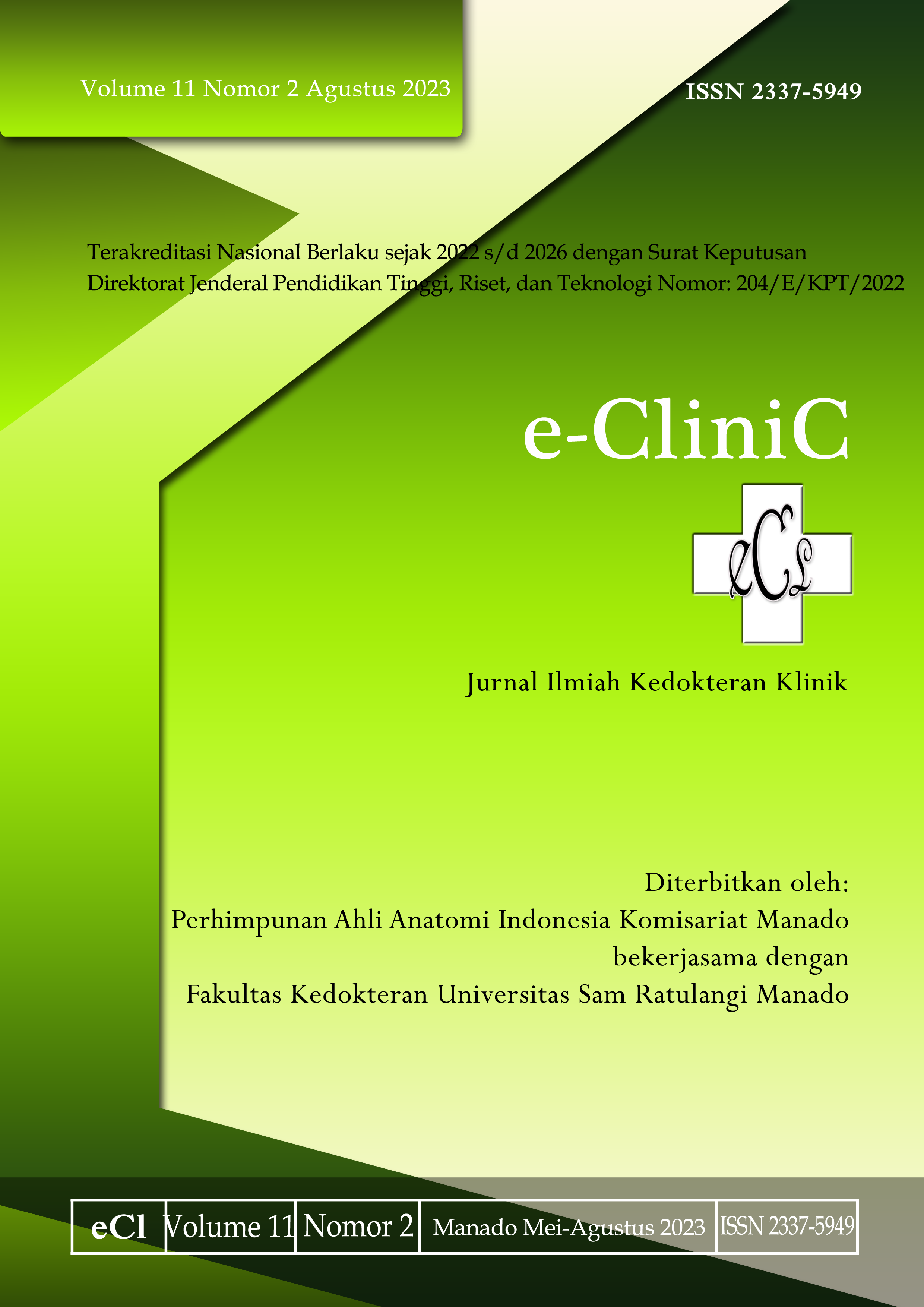Medical Rehabilitation in Patient with Post ORIF et causa Neglected Epiphyseal Fracture Distal Radius-Ulna Sinistra: A Case Report
DOI:
https://doi.org/10.35790/ecl.v11i2.44765Abstract
Distal radius-ulna fracture is one of the most common human osseous injuries, with incidence rate increasing worldwide. There are two peaks of prevalence: the first around the 10th and the second around the 60th year of life. During childhood, they are among the most common pediatric fractures accounting for 19.9 to 35.8% of all pediatric fractures. We reported a case of a boy 13 years old diagnosed as post open reduction internal fixation distal radius ulna et causa epiphyseal fracture. He came to rehabilitation outpatient clinic with chief complaint pain on his left forearm. He underwent a surgery two weeks ago at the distal radius ulna. The surgeon did osteotomy on ulna and then fixated with plate and screw. On physical examination, there were pain and range of motion limitation mainly on the forearm and wrist joint. The patient was treated with low level laser therapy at the surgical wound to promote healing and decrease edema, initial digital motion exercise along with active range of motion of the uninvolved joints. He was also educated about icing and medicamentation if pain still persisted. Once adequate bony healing had occurred, active, active-assisted, progressive passive wrist motion, and strengthening exercise using resistance were performed to maximize the result. At the end of rehabilitation program, there was great improvement on pain and also range of motion improvement. Albeit, there was still a slight range of motion limitation on ulnar deviation and wrist extension by 5 degrees. In conclusion, rehabilitation program is very beneficial in treating post-surgery patient using modalities and exercises to improve functional function.
Keywords: epiphyseal fracture; radius-ulna; medical rehabilitation
References
Hoppenfeld S, Murthy VL. Treatment and Rehabilitation of Fractures. Philadelphia: Lippincott William and Wilkins; 2000.
de Oliveira Gonçalves JB, Buchaim DV, de Souza Bueno CR, Pomini KT, Barraviera B, Júnior RS, et al. Effects of low-level laser therapy on autogenous bone graft stabilized with a new heterologous fibrin sealant. J Photochem Photobiol B. 2016;162:663-8.
Islam M. LLLT Therapy for Bone Healing. Savar: Gono University; 2019.
MacIntyre NJ, Dewan N. Epidemiology of distal radius fractures and factors predicting risk and prognosis. J Hand Ther. 2016;29(2):136–45. Available from: https://doi.org/10.1016/j.jht. 2016.03.003
Schermann H, Kadar A, Dolkart O, Atlan F, Rosenblatt Y, Pritsch T. Repeated closed reduction attempts of distal radius fractures in the emergency department. Arch Orthop Trauma Surg. 2018;138(4):591–6. Available from: https://doi. org/10.1007/s0040 2-018-2904-2
Kalfas IH. Principles of bone healing. Neurosurg Focus. 2001;10(4):1-4.
Hohendorff B, Knappwerth C, Franke J, Müller LP, Ries C. Pronator quadratus repair with a part of the brachioradialis muscle insertion in volar plate fixation of distal radius fractures: a prospective randomized trial. Arch Orthop Trauma Surg. 2018;138(10):1479–85. Available from: https://doi.org/10.1007/s00402-018-2999-5
Quadlbauer S, Leixnering M, Jurkowitsch J, Hausner T, Pezzei C. Volar radioscapholunate arthrodesis and distal scaphoidectomy after malunited distal radius fractures. J Hand Surg Am. 2017; 42(9):754.e1–754.e8. Available from: https ://doi.org/10.1016/j.jhsa.2017.05.031
Shakouri SK, Soleimanpour J, Salekzamani Y, Oskuie MR. Effect of low-level laser therapy on the fracture healing process. Lasers Med Sci. 2010;25(1):73-7.
Huang X, Das R, Patel A, Nguyen TD. Physical stimulations for bone and cartilage regeneration. Regen Eng Transl Med. 2018;4(4):216-37.
Zein R, Selting W, Benedicenti S. Effect of low-level laser therapy on bone regeneration during osseointegration and bone graft. Photomed Laser Sur. 2017;35(12):649-58.
Freitas CP, Melo C, Alexandrino AM, Noites A. Efficacy of low-level laser therapy on scar tissue. J Cosmetic Laser Ther. 2013;15(3):171–6
Khoo NK, Shokrgozar MA, Kashani IR, Amanzadeh A, Mostafavi E, Sanati H, et al. In vitro therapeutic effects of low level laser at mRNA level on the release of skin growth factors from fibroblasts in diabetic mice. Avicenna J Med Biotechnol. 2014;6(2):113–8.
Anders JJ, Lanzafame RJ, Arany PR. Low-level light/laser therapy versus photo biomodulation therapy. Photomed Laser Surg. 2015;33(4):183–4.
Weil NL, El Moumni M, Rubinstein SM, Krijnen P, Termaat MF, Schipper IB. Routine follow-up radiographs for distal radius fractures are seldom clinically substantiated. Arch Orthop Trauma Surg. 2017;137(9):1187–91. Available from: https://doi.org/10.1007/s00402-017-2743-6
Quadlbauer S, Pezzei C, Hintringer W, Hausner T, Leixnering M. Clinical examination of the distal radioulnar joint. Orthopade. 2018;47(8):628-36. Doi: 10.1007/s00132-018-3584-x.
Downloads
Published
How to Cite
Issue
Section
License
Copyright (c) 2023 Christina A. Damopolii, Joudy Gessal, Jonathan P. Suyono

This work is licensed under a Creative Commons Attribution-NonCommercial 4.0 International License.
COPYRIGHT
Authors who publish with this journal agree to the following terms:
Authors hold their copyright and grant this journal the privilege of first publication, with the work simultaneously licensed under a Creative Commons Attribution License that permits others to impart the work with an acknowledgment of the work's origin and initial publication by this journal.
Authors can enter into separate or additional contractual arrangements for the non-exclusive distribution of the journal's published version of the work (for example, post it to an institutional repository or publish it in a book), with an acknowledgment of its underlying publication in this journal.
Authors are permitted and encouraged to post their work online (for example, in institutional repositories or on their website) as it can lead to productive exchanges, as well as earlier and greater citation of the published work (See The Effect of Open Access).







